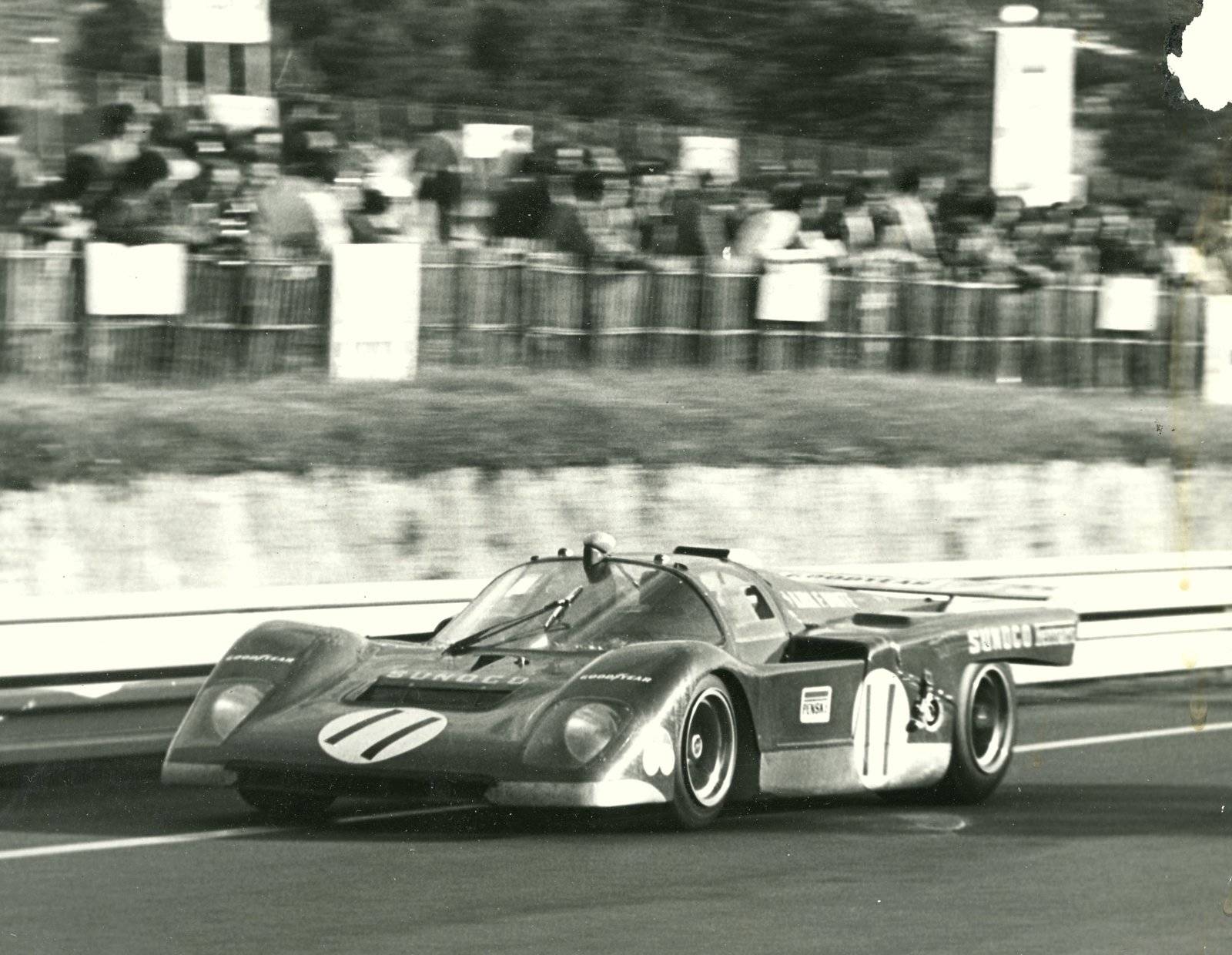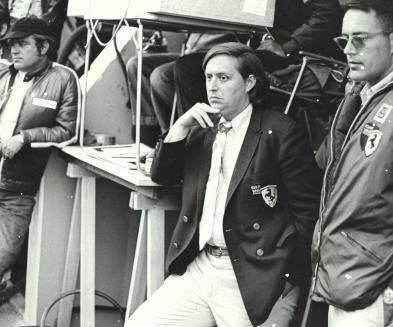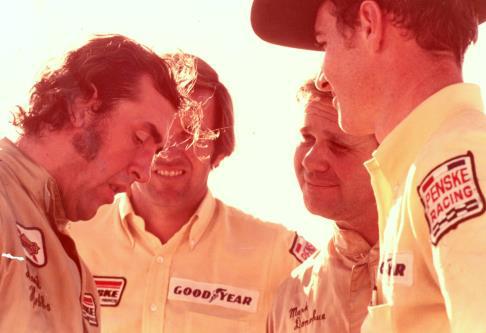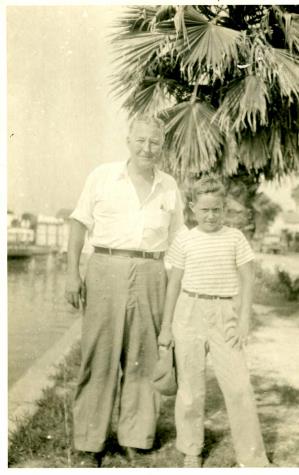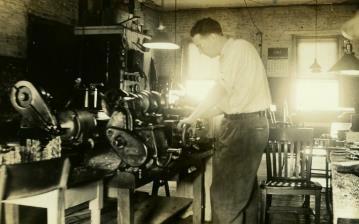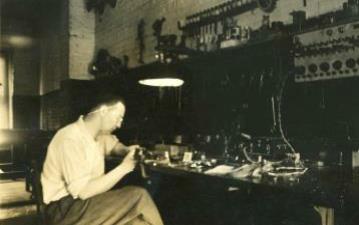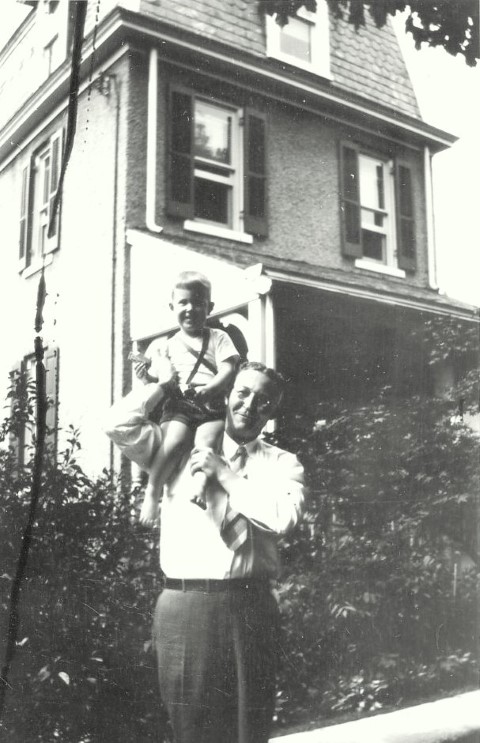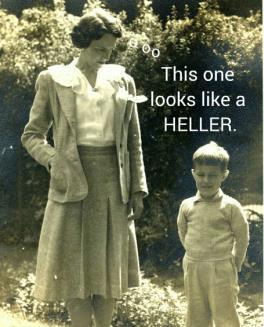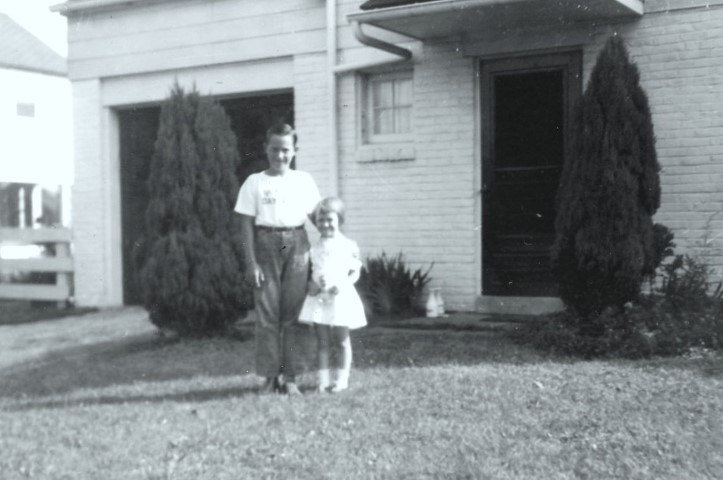By Kirk F. White
1
THE BEGINNING:
Monday evening, June 6, 1971 I boarded an Air France flight in Philadelphia bound for Paris. I had never been to Europe, and hadn’t the foggiest notion what to expect upon my arrival. But, I was travelling there to attend the most prestigious automobile endurance race in the world: The 24 Hours of Le Mans held in southwest France in the heart of the wine country. The race, founded in 1923, has always been the ultimate long distance contest and considered the holy grail of automobile racing challenges. A win at Le Mans brings enormous prestige and honor to the drivers, and to the winning automobile manufacturer.
I should mention that I was going there as an entrant.
By mid-morning June 8, at Orly Airport, I had met up with team member Jerry Riegel, gathered up a rental car and was dealing with a French road map, trying to scheme a route to Le Mans. The English language, it seemed, had all but vanished from this area of the world. About halfway to the town of Le Mans, we stopped by a roadside layup to get a bite to eat and use the facilities.
As to the “facilities”, I couldn’t determine which “door” to use; then I saw a man step out of one of the “bathrooms.” But then . . . a lady stepped right in just as he came out! I waited; she departed and I entered the small circular building. I closed the door and in the dim light I made out a circular cement ring with a bit of water trickling through the base. There were cement foot pedestals inside the circle!
Chapter 1
4
building. Baus was waiting and quickly re-introduced me to others in the room. We were soon seated at a polished conference table.
There was much fawning over the Penske/White/Sunoco Ferrari 512M, and our having come all the way here to race. And, such a very fine Ferrari we had brought! Everyone agreed the car should have won both Daytona, and Sebring.
There were now four suits seated at the table, and I was as happy as could be. What fun over here, I thought. Everyone is so very nice, so gracious.
“Your oil company, Sun, has no presence in France, in fact not in all of Europe.” Baus said.
Softly, the other shoe had dropped, the music had stopped, and I felt quite uncomfortable.
“You will be running BP fuel and lubricants while you are racing here at Le Mans,” one of the other suits said.
I expressed the team’s appreciation, having no idea whether their claim had any validity.
“You must run BP markings on your Ferrari.” said Baus.
No, I explained smiling, that Sun Oil was our primary sponsor and we could not run BP logos on the car. It simply could not be done, I said.
On top of that, there appeared to be, four dozen Porsche 917’s, that had showed up for the race. You couldn’t keep track of them all! However, three of the 917’s were equipped with the amazing Porsche factory long tail bodywork. Boy, were they long, to say nothing of the fact that they were mighty rapid. The “longtails” were all clocking at least 230 MPH down the Mulsanne!
Thus our long faces.
I asked Luigi Chinetti who the “man” was that had been sent by Maranello. Luigi was not pleased with the one inch N.A.R.T. markings on our Ferrari, and he was happy to scoff at me that the “man” they had sent
"Le Mans 1971" Credit: David Friedman.
By the end of the “evening” practice session no one in our camp was in a particularly good mood.
Thursday, June 10, was overcast. I had risen early, to the cheerful sounds of a children’s schoolyard next to our hotel. What a grand way to wake up each day, I remember thinking.
After a bit of business, and a few, difficult telephone calls to the US, I headed over to our Shell filling station in downtown Le Mans.
I have to say, that each time I caught sight of our Ferrari, it took my breath away. That extraordinary Penske/White Ferrari 512M of ours had such a stunning beauty to it, and Roger Penske’s organization, had masterfully built the car to a level where it was undeniably the fastest Group 5 Ferrari on earth. . . Group 5 being the 5 litre thundering lions of sports car motor racing.
Less than a year prior, my involvement in most forms of motor racing involved little more than being an ardent fan and spectator. Yet here I was in Le Mans, France as an entrant in the world’s most prestigious endurance race!
Our Ferrari was being touted as the first “highly potent” Group 5 entry at Le Mans, from the United States, since the massive assault by Ford
Credit: Michael Sesit
L to R: David Hobbs, Heinz Hofer, Mark Donohue, John Woodard (Credit: Jonathon Rawles)
As I walked through the garage door that morning, the team members were present, and indeed, I saw Mark was in the building.
My arrival seemed to cause a number of people to pause, and peer in my direction; a few simply stared. Some had rather amused smiles, or smirks on their faces. I was being singled out, and the conversation level seemed to drop a bit.
I thought I must have been particularly odd looking that morning . . . I glanced twice, and my fly was not open. After an inordinate amount of time, the staring, and bits of amusement caused me to suspect that not only was something up, but it appeared that it may involve me!
At supper one evening my father George, opened the idea of the two of us rebuilding an automobile engine together! He felt it was time for his son Kirk, to fully grasp the workings of the internal combustion engine!
I was very fortunate to have a Dad that would undertake such a project. At age 10 a boy may know how to change out the spark plug on a power mower engine, but to overhaul an entire automobile engine was an altogether different opportunity.
However, my Dad, George Albert White, was an exceptional man. Among a host of talents he was a remarkable mechanical engineer with Leeds & Northrup in Philadelphia. My father held several patents in his name including one for the phonograph record changer that prevailed up through the 33 1/3 LP’s!
Dad had a heart condition they called “Angina Pectoris”. Back in the nineteen forties Nitroglycerin tablets were his only aid. No bypass surgery for George White in 1949. Apparently, my father had carried the condition for a long time.
Certainly, there was no life insurance for a guy with “Angina.”
Mother, my younger sister Mary Linden, and I were on our own.
I was completely engulfed in grief, and I was terribly scared. It seemed impossibly hard to draw a decent breath. The whole world had turned on its head. Over the following few days everyone from everywhere came to our home. All of Mother and Dad’s friends, and families from Leeds & Northrup came. More family came from Mother and Dad’s home town of La Crosse, Wisconsin. My father’s brother, Uncle Kirk and Aunt Helen came from Tulsa, Oklahoma.
2
I had just encountered my first pissoir . . .
Returning to the car, I briefly considered returning to Orly airport. I was not prepared to deal with such primitive plumbing facilities while in France!
At the same time that I was carrying on over the French public plumbing, Peter Reinhart, with Bernard Cahier’s carefully crafted paperwork in hand, was tediously ushering the Kirk F. White / Penske Racing / Sunoco Ferrari 512M through French customs at Orly airport. The Ferrari Group 5 racing car was masquerading as a Pennsylvania registered road vehicle, hopefully bypassing the need to post a huge bond, (upwards of a million dollars!)
We drove on, and arrived at the Le Mans circuit midafternoon. I had expected the actual racing circuit be set in the bucolic French countryside with a small dedicated bit of track, tied to the public roads that comprised the circuit during the race itself, with the Esso Tower and some minor grandstands. Instead of lovely French farmland, I came upon a complex at least the equal of the most recent New York World’s Fair! The towering grandstands appeared as tall as Indianapolis.
Within the grounds, we traced our way through a maze of roads, which crisscrossed more roads, heaps of officials, flags, and signs, etc. Neither of us could read nor even remotely understand what the signs said! There were an abundance of buildings, storefronts, stalls, and shops. Many of the stores were high profile, quite fancy European shops such as Cartier, and Hermes. The shops were dedicated facilities that were shuttered all year long except for the days of the racing event each year. The 24 Hours of Le Mans drew the largest spectator turnout on earth, at upwards of half a million people in those days
3
We finally located the building that housed the almighty “Credentials” and the “Officials” who doled them out. You cannot imagine just how much the French treasure “Officialdom” and the very idea of “Credentials!”
Our gracious friend, Bernard Cahier, the single most adept gentleman in all of motorsport, had again seamlessly put in place all the items we would need. And boy, were there a bunch of them!
Almost the moment we were loose of the credentials office an “official” type gentleman, well dressed in a bespoke suit, and sporting a multitude of arm bands approached me along with two other men.
“You are Kirk F. White, no?” the gentleman said, in a thick French accent.
“Yes, I’m Kirk White,” I said.
“I am Gianni Baus, and this is . . .” and two other gentlemen were introduced. I realized that I knew Baus by sight. I had seen him before in the company of Luigi Chinetti, the United States distributor for Ferrari, at one or two of the major endurance races and at Bridgehampton in America. He was a high ranking official within the FIA, (Federation Internationale de l’automobile) the governing body of motorsport throughout the world.
“Could you join us at five this afternoon, for drinks, and a visit?” Baus said.
It was an insistent invitation and we were to meet at the BP Oil building which was a prominent structure that towered above the track. The gentlemen were most gracious. Of course, I’d be pleased to join them.
At five PM, I entered the BP building, and a gentleman escorted me to the elevator. I ascended to an elegant dining room on a higher floor in the
5
“You must run BP logos, or you cannot participate in the race,” said Baus.
(. . . The entire episode was wholly unreal. I’d been in France mere hours, and here I was in a suite in the British Petroleum building, in Le Mans, France, trying to carry the Sun Oil banner through this wholly unanticipated battlefield. . . .)
I stood my ground figuring this room full of suits was not really in a position to send us home. The publicity surrounding our Ferrari coming to Le Mans was vast.
We debated every aspect of their insistent request; finally Baus said we absolutely must, but the logos did not have to be large. Two four inch BP stickers would do. There I was, stuck in this tower of hostile aggression, these guys were driving the bus, and there appeared no way for me to step off . . .
My brain was sweeping over the entire surface of our Ferrari trying to come up with a tiny bit of real estate that would be of no consequence.
Then, it came to me . . . that thin back panel at the rear of the car just below the wing and right above the exhaust pipes . . . Hell, I knew that anything on that panel would quickly be invisible at 50 or so miles into the race from the exhaust rollover and the dirty air back there.
“Very well”, I offered, “we will run two of your logos in a prominent spot on either end of the back panel just below the wing.
“It is a clear spot with no other sponsor markings. It is a good ‘open field’ for BP.” I said.
6
At that point, I believe everyone at the table was anxious to call it a day, and agreement was reached. We stiffly, but cordially, said our adieu’s and that was that.
My friend, Jerry Riegel had been patiently waiting for me to emerge from the BP building. We drove to the city of Le Mans and checked in to the Hotel Moderne downtown. Again Bernard Cahier had arranged the hotel accommodations, as well as a garage area for the Ferrari while it was there in LeMans.
Indeed, the plumbing facilities were just fine in my hotel room, although oddly there was a second smallish “toilet” with no lid . . .
Wednesday morning, after a brief breakfast we drove to a downtown Shell filling station with an attached repair garage. It would be our team headquarters for the time we’d be in Le Mans. The owner of the facility was your quintessential, diminutive French garage keeper, always a cigarette dangling, worn soiled shop coat, sad eyes, and, as close as I could tell, he had a light buzz underway right around the clock. He was totally nonplussed by the Ferrari, but seemed to enjoy having all the people bustling about.
Like most everything else at Le Mans the scheduled practice times were set oddly. Wednesday’s practice was scheduled from 6 PM to 10 PM. Thursday’s would be from 7-10 PM; there would be no practice at all on Friday, the day before the race.
I’ll mention that in France, at that time of the year, it stays light quite far into the night.
When I entered the garage that Wednesday morning our Ferrari 512M was sitting there looking fit for battle, albeit still masquerading as a Pennsylvania road car, its license tag still attached.
7
I took note of the rear panel that I’d given over to BP the previous evening, and felt the arrangement should really work out. Those 4 inch stickers would disappear in the exhaust rollover pretty damn quickly.
As a group, we were there with a very tight number of team members, but we had two of the finest long distance drivers in the world: Mark Donohue and David Hobbs. Here at Le Mans, Mark was also the team manager. He was totally stoked to be racing here. For Mark, a victory at Le Mans meant more to him personally than a win at Indianapolis. Fred Marik of Professionals in Motion, and Judy Stropus, timer extraordinaire had also come over with us.
Initially, in early April, when we had filed our entry form for Le Mans, we were promptly informed that we were too late. Fortunately, Luigi Chinetti, three time winner at Le Mans, the United States distributor for Ferrari, and the Patron of the North American Racing Team, released one of his Ferrari 512 entries to Penske Racing. Chinetti was one of the true sportsmen of the era. Others may well have thought him daft to have given us the entry!
Just before leaving for France, I had said to Roger that the team’s superb graphics painter, Larry Schoppett would have to post Chinetti’s “N.A.R.T.” logo on the car acknowledging that our entry was indeed under their banner.
Roger had given me a vacant look that pretty much said: “I don’t think so . . .”
I had said to Roger: “Listen, I do business with Chinetti constantly and he has literally given us his spare entry! We would have been in a bad corner without Luigi.” Just have Larry put it on before or after my name on the car; it’s not a big deal.”
8
In looking the car over there in the Shell station I didn’t see that the paintwork had been done. Oh, wait a second, there it was right behind my name, and the “N.A.R.T.” wasn’t much larger than the size of the type that you’re reading on this page!
I made a note to thank Roger for his generous effort!
The garage was filled with people coming and going as the station was open for normal business and our shop “area” was not restricted in any way. There had been tremendous publicity all through Europe covering the car coming from America. All of the newspapers had photos and articles, none of which I could even begin to understand!
Roger wasn’t there yet. I went to Mark and explained what had happened the previous evening with the BP people. Mark listened carefully, then shook his head slowly, and said:
“Roger’s not going to like it a bit, but you chose the right spot for the stickers; you can’t put anything taller than four inches back there, and we can keep a couple of guys stationed at each corner at the start, or whenever we need to. . . .”
Shortly thereafter Roger came through the door, and Mark said to me, under his breath:
“You tell him . . .”
I waited until Roger got his bearings in the shop, and then attempted to give him the “short version” of what had transpired Tuesday evening
It didn’t go well.
9
“No way, we’re not doing that! BP? Where the hell do they get off pulling that?” Roger’s voice was growing louder, and then he said;
“That’s it, pack it up, we’re going home!”
At that point everyone was watching for what might be coming next. Mark gave us both a withering look, that pretty much said:
“Sort it out, boys . . .”
He wasn’t far off with the “boys” comment. In 1971, I was 33 and Roger was 34!
I went over again with Roger the tiny bit of space I had given up on the trailing edge of the car, and it was agreed the logos would vanish in the dusty exhaust quickly.
Not five minutes later, Roger took me aside and mentioned that he had been invited to lunch with Mrs. Louise Porsche Piech, wife of Dr. Ferry Porsche and herself a major force within the Porsche organization.
What unfolded at that luncheon, was the very beginnings of one of the most stunningly successful programs in all of motorsport. At that luncheon, Porsche approached Penske Racing pinpointing not only the talents of Roger, Mark Donohue, & Don Cox, but the entire Penske organization to develop and campaign a “no holds barred” Cam Am effort.
Certainly the stunning Donohue/Parsons, Penske victory at the Daytona 24 hours in 1969 with a lone Lola GT leaving five factory Porsche 908’s in its wake still smoldered in Porsche’s mind. Past that the incredible level of preparation and the capabilities of our Penske/White Ferrari 512M had certainly played a role in Porsche’s decision.
10
The rest of the Porsche Can AM story is well known. Penske Racing went on to literally devastate the American Can Am series developing, racing, and winning, with the incredible Porsche 917/10 and the 917/30’s .
That splendid news aside, we loaded up the Ferrari and commenced Wednesday’s late afternoon and evening practice at the track. Mark and David took to the track, endeavoring earnestly to set the Ferrari up. It didn’t go easily. Everyone’s demeanor seemed crossed between serious, and “this is not what we were hoping for.”
The Ferrari factory had sent “a man” from Maranello to assist our team and the nine other racing 512’s that were entered. All of the 512’s were there as private entries, and “the man” was the only Ferrari factory representative at the race!
I know, it didn’t seem quite enough to me either.
The Ferrari factory “man” advised a final drive gear ratio for us that was far too short, and our car ran out of “gear” halfway down the fabled 3.5 mile Mulsanne straight. We were running at a top speed of only 205 MPH!
11
worked in the Parts department at the factory! Not exactly one of the top wrenches from Ferrari’s racing department.
So, okay then, Porsche had showed up with aerodynamic bodywork that spanned two zip codes, posting enormous speeds, and our factory “parts” guy had missed our gear set up by a mile!
Mark and David could run anyone down anywhere else on the course, but that damn Mulsanne straight was 3.5 miles long!
12
in the late sixties. Certainly an overstatement, but between Roger Penske, Mark Donohue, David Hobbs, the fact that the car was wickedly fast and stunningly beautiful, it had captured worldwide attention.
I was having no end of difficulty believing that I was actually at Le Mans. And I was still absorbing the amazing circumstances that had brought all of us here to France to contest this legendary automobile race!
Our Le Mans neighborhood Shell station, or race headquarters, if you will, was hardly a Penske Racing type facility. The untidy disarray of the Shell station must have bothered Roger no end! Indeed, an observer may have wondered just how “extraordinary” our “Big” American effort really was.
However, our garage had been discovered by all manner of racing press, friends, fans, and curious locals. The place was awash in people, most speaking French, German or Italian. Largely, they were casting about for a glimpse of the Ferrari itself. Or, if they were lucky, they may have come across someone famous, such as Roger, or either of our star drivers, Mark Donohue or David Hobbs.
13
Suddenly, a photoflash went off, then another, quite close to me. In fact, the cameras were pointed at me! I moved through the crowd, and sought out John Woodard who was the chief mechanic on the Ferrari.
He was smiling as I approached him: “John, what the hell is going on here?”
“You’re joking!”. . . You haven’t seen it?” John said.
“Seen what??” I asked.
He handed me a newspaper.
There, on the front page of France’s largest daily newspaper, “France-Soir”, top of the front page, center, was a substantial photograph of me. It had been taken during the previous evening’s practice at the circuit, standing trackside in front of our pit.
“What the hell is this?”. . . I muttered to myself.
Picture, if you will, the following:
In the photograph, there I stood for all of France, my arms crossed over my double breasted blazer, with an outrageous Pulitzer necktie, and Gucci loafers. To top it off, I had foppishly long hair!
And, I was bearing a grim expression to boot!
The photographer had captured this glorious image with his camera shooting from a lower angle. The result was a portrait that could charitably be described as not terribly flattering.
14
The caption declared in French: …”Un Milliardaire Amercain a transforme une Ferrari por gagner au Mans”….
(“Listen, I didn’t know what the hell it said either, but I could scheme out enough to know that I was probably not going to care for it .”).
In fact, it said: “A Multi-Millionaire American transforms a Ferrari to win Le Mans”.
The article went on to say, with authority, that this young American Multi-Millionaire had come to conquer Le Mans utilizing the services of “Engineer” Penske!
Additional reference was made to my taste in attire, and the story carried on implying that the Gulf Wyer, and Martini and Rossi Porsche teams were frightened at the very sight of me!
“MULTI - MILLIONAIRE??” . . . How had I ended up in such a bizarre, “Alice in Wonderland” scenario??
The article was so incredibly off the mark. My mind kept expecting the entire episode to simply evaporate. I looked up from the newspaper hoping everyone would be laughing at the elaborate joke they’d pulled on me. No luck, people were still staring at the “multi-millionaire”.
Then Mark Donohue, as only Mark could, put the capper on it:
“Anyone who comes to practice at Le Mans in Gucci loafers with no socks deserves whatever he gets . . .”
* * * * * * * *
15
Where to start . . .
1) . . . Less than two years prior to this 1971 LeMans weekend I was folding up a card table that had served as my entire automotive business office at my home in Radnor, Pennsylvania. My tiny, fledgling classic car business was moving on to a small garage in west Philadelphia.
. . . Less than two years prior to this 1971 LeMans weekend I was folding up a card table that had served as my entire automotive business office at my home in Radnor, Pennsylvania. My tiny, fledgling classic car business was moving on to a small garage in west Philadelphia.
2) . . . And, just a year or so before that, I had just sold my very first old, “used,” not yet “vintage,” competition Ferrari.
. . . And, just a year or so before that, I had just sold my very first old, “used,” not yet “vintage,” competition Ferrari.
3) . . . And, prior to that for a number of years, I’d been a reasonably successful life insurance salesman who followed these hallowed classic racing venues, such as Le Mans, only by grainy television coverage and newspapers!
. . . And, prior to that for a number of years, I’d been a reasonably successful life insurance salesman who followed these hallowed classic racing venues, such as Le Mans, only by grainy television coverage and newspapers!
I don’t see even the sketchiest makings of a multi-millionaire here, do you??
So, before I return with the rest of our amazing adventure at Le Mans, or anywhere else for that matter, I must attempt to lead you up to what could have possibly ushered in such an extraordinary scenario. Thus far, this entire episode has been on the sharp edge of bizarre, and it’s scarcely underway!
So, here is . . . “the rest of the story.”
* * * * * * * * * * * * * * *
16
THE TRUE BEGINNING
I expect that for me, the path to all things automotive may well have started at a point in the late summer of 1948. I was ten years old, and I lived with my family in a very small home located in a small neighborhood called Oreland, outside of Philadelphia.
17
South Bend metal lathe, an equally fine well cared for floor drill press with a secondary multi-axis table for small milling tasks, grinders, polishers, and every tool you could think of. Big, labeled “Saltine” tins held every hardware item, and fastener known to man. Working in my father’s shop, one never had to go out to purchase anything; it was all right there.
At the age of eight, my father had carefully taught me to operate most of the machinery in his workshop. Under his watchful, guiding eye I’d been taught to execute a number of precise machining projects. And precise was the standard for any project that came out of Dad’s shop.
“THE G.A.WHITE & SON ENGINE REBUILDING CO.”
So, on a sunny Saturday morning in the early fall of 1948, my Dad and I drove down to the Mount Airy section of Philadelphia in Dad’s very sensible, gray, 1941 Willys four door sedan. We were responding to a classified ad in the Philadelphia Inquirer newspaper offering World War II surplus Jeep engines.
The newspaper advertisement landed us at the front door of the most amazing place I’d ever seen in my ten years!
“Leech Brothers” the sign said. We pulled up and parked in front of their, uh . . . “Office.”
The place was incredible! Leech Brothers was the very epitome of a nineteen forties American automobile scrap yard, and it was fully a city block square.
Its many acres were hemmed only by a rickety, falling down ten foot, wooden fence.
18
There were hundreds of old, wrecked, junked, or long ago abandoned automobiles, along with all of their attendant bits and pieces in that yard. You could almost see the grease and oil oozing out from under the bulging fence boards. The place was literally jammed with discarded automotive clunks of every type.
The Leech Brothers office interior was a rich “drain oil” brown, with stacks to the ceiling of those parts that were too precious to be left on the carcasses out in the yard. The pungent office aroma was that wonderful “old garage” essence that can only be gained through the presence of stale gasoline and oil, steel, leather, old rubber bits, generators, starters, and hard working men.
In addition to having the perfect surnames, sketched for us in the ovals on their dark blue work shirts: “Vinnie” & “Jimmy,” the Leech brothers were the quintessential automobile scrap yard operators. Both brothers were short, heavy, slicked back hair (with axle grease?) and hands that looked like they’d taken apart every car in the yard themselves. What a pair they were. I would come to know them well in future years.
Dad and I were there for one of the $5-$7 “war surplus” Willys Jeep engines Leech Brothers had advertised in the newspaper.
“Sure, we got a pile of ‘em out there; take your pick,” said Vinnie.
“If nothin’s busted off ‘em, they’re $7 bucks each.”
Dad and I wandered out through the yard. “What a neat place…” I thought.
Big cars, small cars, wrecked cars, burned cars. They were piled on top of each other, in some places two stories high.
19
Wending our way through the tight “aisles” in the yard we came upon a relatively open area where a stogie chomping character was sitting at the controls of a full blown crane, swinging a huge electro-magnet at the end of the cable, far out on the crane’s boom.
The operator was lifting entire automobiles by their roofs, and with the most remarkable grace, was able to literally toss the derelict hulks anywhere he pleased.
In one motion, he would lift the car, swing it wildly, and at precisely the right moment cut the juice to the magnet and hurl the remains roughly where he wanted it.
I’d just found my line of work, when I grew up!
Dad urged me along, “this is no place to be gawking, let’s find those engines.”
Dad inspected several “used up” Jeep engines before we settled on one.
My father always made sure that I was truly a part of whatever we were doing together. In that scrap yard he took the time to show me each thing he was checking out, and why. Intact freeze plugs, a water pump that turned smoothly, manifolds that weren’t cracked, an undamaged distributor, carburetor, and generator. We found a good engine, wrapped it up in old blankets, and the yard workers “fork lifted” it into the trunk of the Willys.
Dad had been pleased with the engine we settled on. So was I.
When Dad and I reached home with our treasure, we quietly enlisted a neighbor and his son to help us load the engine on a dolly.
20
I clearly recall that my Mother wasn’t at all thrilled with the dirtball lump of an engine that all of us were dragging through the yard, on around to the shop.
Dad spotted Mother on her way out of the house, about to give us, “what for . . .”
My father chose to make light of it and asked Mother if she’d like to have a better look at our prize, as the rest of us stood aside.
My Mother had fixed my Father with one of her steely stares, shared it briefly with me, turned and left in an icy huff. Chuckles were shared between the men.
Over the course of several weeks following our acquisition, we got into the engine project in earnest. The easiest part had been the total disassembly of the engine, cataloging each piece, cleaning it, (Boy were they dirty!), learning what each piece was and it’s function.
Each time we would return to work on the engine, we would review what we had done previously, and I’d be expected to have some proper answers available for any “pop” questions Dad might fire at me.
By early January of 1949, we had reached a point where we were well on our way with the reassembly.
THE END OF THE WORLD . . .
January 16, 1949 was my mother’s birthday. About 5:30 that afternoon, I announced that I was going next door to our neighbor, the Bryden’s, to see my pal Chuck for one silly reason or another. My Dad was stretched out resting on the couch.
21
“It’s close to dinner son, stay here; it’s your mother’s birthday,” Dad said.
“I won’t be that long . . .” I said, and barreled out the door.
Twenty minutes later the phone rang at the Bryden’s house. Georgia Bryden yelled for her husband Don and they dashed for the door. I was told to stay right where I was.
My father, my wonderful loving Dad had died of a massive heart attack.
I was ten fucking years old, for God’s sake!
22
After a beautiful service at St. Thomas church in Whitemarsh, mother somehow hosted a reception at the house for the family and friends.
I well remember my dad’s older brother Uncle Kirk had had a bit too much to drink. He took me aside and wept his way through the soon to be familiar refrain of:
“Son, you’re the man of the house now, and you’ll be taking care of your mother and your young sister; that’s what your dad would want.”
He then proceeded to hand me all of the cash he had with him, which was a hell of a lot of damn money!
From absolutely nowhere, my mother’s swift hand deftly reached in, and scooped the cash right back out of my hand, easing my Uncle Kirk away from me.
I mean what the hell . . .?!
Following Dad’s death, my mother was, almost immediately, forced into striking out to find a way to support us.
Mother and Dad had been born and raised in La Crosse Wisconsin. Unlike George, Mary Law Finch had been born and raised in an opulent fashion, her Grandfather had been a four term Mayor of La Crosse, and her father had been the publisher of “Times Republican” newspaper. He had also served both Presidents William McKinley, and Theodore Roosevelt as Ambassador to the countries of Paraguay and Uruguay. Mary Finch White had never had to worry about sustaining herself, let alone my sister and me.
However, Mary White was resilient. She was also tenacious and went after this frightening responsibility relentlessly. She had no resume to offer. She only possessed an overwhelming need and she was bright as hell.
23
Three weeks into her search she interviewed two pediatricians in the Germantown section of Philadelphia. They had a large pediatric practice that was lacking a proper business management system. Both Doctors saw something in Mary White that sparked their enthusiasm, and they hired her. My mother remained with that practice and its various partners for 35 years!
My sister Mary, being just age 5 was sent to a church boarding school.
 | ||||
 | ||||
 | ||||
Following World War II, he was awarded the distinguished “Naval Ordinance Development Award” for his engineering work with the Navy on the submarine periscope system that was developed during the latter years of World War II. That Navy assignment had relocated us to Ft. Lauderdale, Florida, while Dad worked out of a secret Submarine base just off the northeast tip of the Everglades.
After the war ended, our family returned to our home in Oreland, Pennsylvania.
By 1948, my Dad’s shop at our home, which he had built just behind the house, was extremely well equipped, having an older well cared for
 | ||||
 | ||||
Just a few weeks later, I turned 11, which didn’t help me at all in grasping the business of becoming “the man of the house,” now that my father was gone!
The following months were incredibly difficult for the three of us. Mother had suddenly become the provider, the only parent, and my five year old sister Mary Linden had essentially vanished out of our lives except for visits, and distant holidays
Would it be like this the rest of our lives?
* * * * * * * * * * * * * * * * * * *
. . .COMING NEXT: A ray of light . . February 16, 2016
Last photo of my dad and me.


